Trip Report: 4/5/2020
This is the time of year that I briefly switch to chasing panfish on the ice, until there is no longer any safe ice to fish. Walleye/Northern pike/bass season closed way back at the end of February and my beloved lake and stream trout are off-limits as of the end of March, too. Of course, I could hang it up and wait for stream trout to open on April 18th, or just relax and wait for the official start of the season May 9th, but what better way to enjoy this early spring weather, get in some exercise and stock the freezer with delicious panfish to enjoy this summer?
Disclaimer: In an effort to protect the fishery and encourage those of you looking for adventure to put in a little legwork of your own, I will not name the lake I visited. A little research will probably narrow it down quite significantly. I will say it is a lake that contains Crappies and Walleye and can be found within 20 miles of Ely, fully inside the BWCA. I will refer to it as “Lake” in this blog.
While I have heard this Lake is great fishing all year-round, and specifically during the spring when the melt is starting and the crappies are active, I have never been myself, so I didn’t know what to expect. The last 2 miles of road leading to the entry point parking lot was not plowed all winter, so there was still 12-20” of compacted, slowly melting snow. We chose to bring a snowmobile to travel the final two miles to the entry point, instead of risking the drive, or walking an extra two miles, which would push our trip close to 8 miles total. I am glad we decided not to drive, as there were two gentleman who buried their giant SUV on the road attempting to do just that.
From the entry point, our route is going to take us across a long portage (200+ rods), across the first lake, across a winter use trail and to our destination Lake – we should only have to travel about 2 miles one way. We left the snowmobile at the entry point and were hiking by 9am.

The portage has been traveled frequently this winter and was easy going on the way in as it is mostly downhill – not so much on the way out. About 100 rods into the portage we stopped for a break to photograph an old white pine that had broken off 20 feet above the ground during a recent windstorm – likely the 2016 blowdown. It was a magnificent site; the tree was at least 10’ in circumference and abruptly cut off at 20’. I can’t imagine the amount of force that would break off a behemoth tree like this in such a thick part of such a healthy tree.
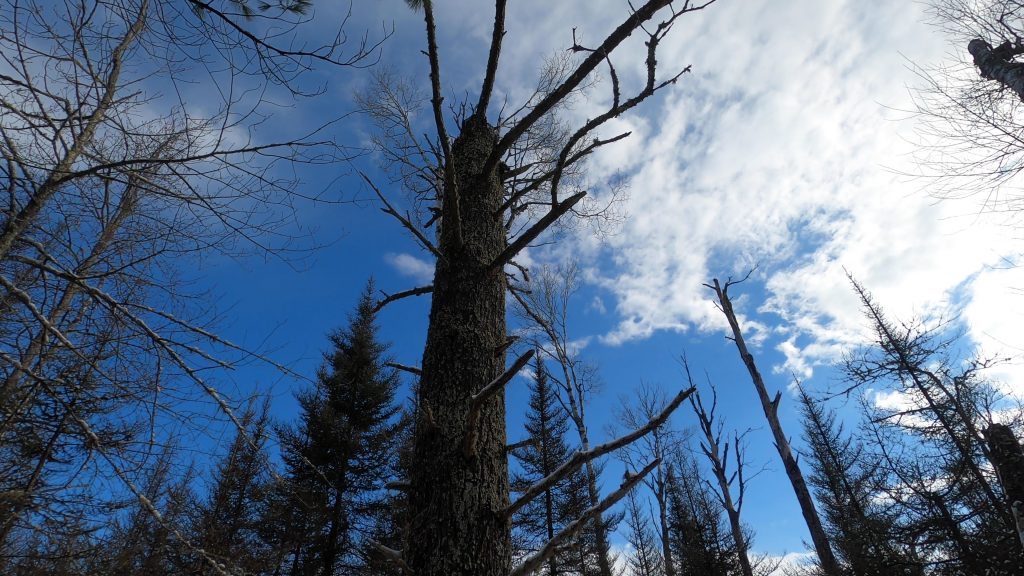
Or could I? My mind immediately flashed back to that muggy, humid, stale day in July. By coincidence, I had spent the night at the Fall Lake Campground that day visiting on a work trip and had awoken in the middle of the night to the freight train sound of the wind shaking the trees anchoring my hammock, bouncing me around like a rag doll. Luckily, I was able to retreat to my car, and ultimately the park shelter to wait for the storm to pass. For those of you familiar with the history of that storm, others were less fortunate and didn’t get out alive. When I returned to my hammock after the storm was over and the sun rose, I could see the carnage: trees fell all over Fall Lake campground (one about 20’ from where I was sleeping), littered the Fernberg all the way back to town, and Ely was without power for days. Luckily, none of the trees that fell in the campground that evening injured anyone, but a few campers and tents were damaged by falling branches and small trees.
Shortly after we stopped, we were approached by a conservation officer on cross country skis. He reported that the Lake has been busy lately due to the warm weather and great travel conditions, but he hadn’t heard much about the fishing, which he thought meant it had been slow the last few days. After checking our licenses and asking about our gear to ensure we didn’t bring in any glass or cans, he was on his way.
The hike in was absolutely gorgeous! Our timing was perfect. We avoided the cold of the early morning but were out early enough that nothing had started melting yet, so travel was easy. The winter use trail that connects the first lake and the Lake travels over a bog/marsh, but luckily the snow was packed enough we didn’t break through even without snowshoes. Although not 100% necessary, I was glad I had traction spikes on my boots when we were hiking on the ice to avoid slipping. The trip in probably took us a little over an hour, stopping for pictures/videos and to exchange pleasantries with the C.O.
As I had never fished this Lake – this was actually my first time at this entry point altogether– I had no idea where to start fishing. Luckily, many had come before us, so we had the benefit of starting our search for fish using the existing holes, which were easy to reopen with the chisel end of my ice scoop. Our first spot was in 17-18’, a circle of about 20 holes likely drilled by someone the day prior. We only spent about 10 minutes at this spot – checking depths and looking for marks on the sonar with no luck.
We noticed the others fishing on the lake were in deeper water, so we decided to try our luck a little further out from the island shelf in the deep basin. We started marking fish on the sonar almost immediately, so we unpacked our gear and started the process of figuring out what it was the fish wanted to eat. The bait shops that do remain open in Ely are completely sold out of minnows of almost all species. “We stopped getting bait deliveries once this whole coronavirus thing started,” one owner told me. I was fortunate enough to find one of the remaining two 250 count wax worm containers at one of the gas stations that carries bait before our Brook Trout trip last weekend, so I was hoping small jigs tipped with wax worms would do the trick. Normally I would bring live crappie minnows to jig and set up on our dead sticks, but the wax worms proved to be enough, with the correct jigging cadence, to entice a bite.
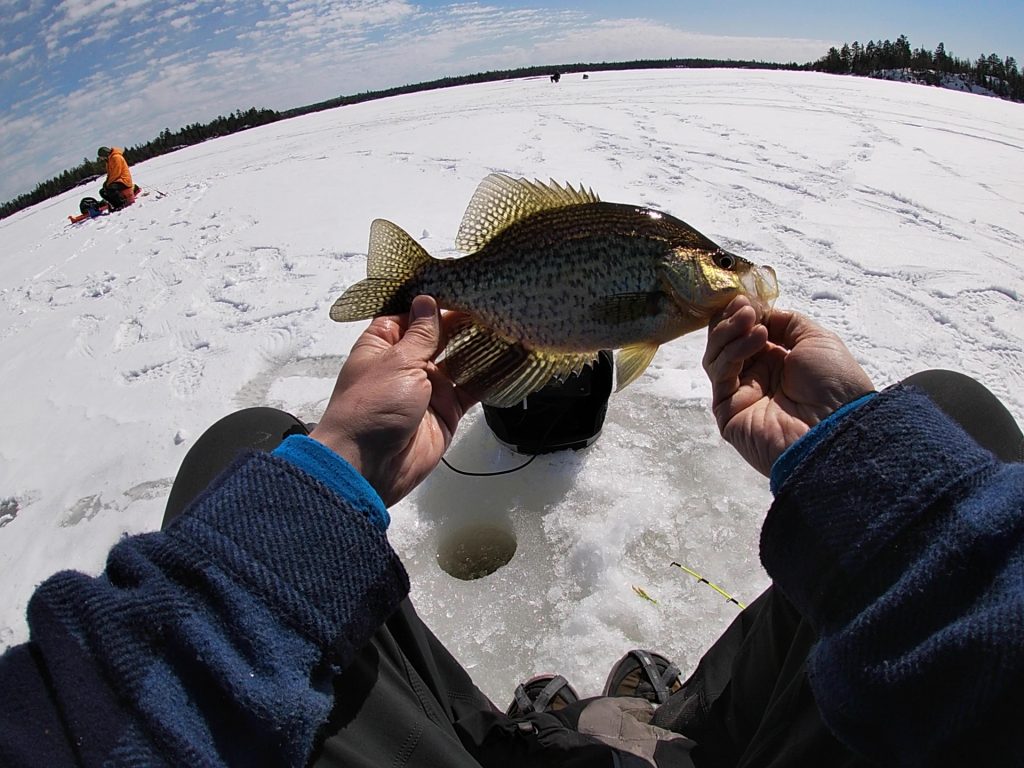
The fishing actually started out pretty slow – I don’t think we put our first fish on the ice until 20 minutes or so after we started fishing. The fish were finicky and behaving strangely (in my experience) for panfish. Rather than moving very slowly in large schools spread out on different structure throughout the lake, these fish almost always traveled in pairs (at most I marked 4 fish on my sonar at one time) and were often as aggressive as the trout I had chased all winter-chasing our baits up to 8 feet before striking. We had the most luck in 20-21’ of water, and the fish almost always appeared on the sonar from 12-16’ under the ice and would almost always chase the bait up 2-8’ to get a good look before committing, or slowly returning to their cruising depths.

While we came for the crappies, my first fish of the day was a Tullibee (cisco), a species of whitefish found on many lakes in the boundary waters. This was actually the first time I had caught this species of whitefish. Tullibee are rarely caught with rod and reel, they are generally netted in the fall when they are clustered together while spawning. The only time I have seen these fish is when cleaning lake trout for shore lunch in the spring/summer/fall and doing stomach samples to see what they have been feeding on. The tullibee I see in the stomach samples of trout are usually 7-10”. The Tullibee we caught today were massive in comparison, the largest being a healthy 1.25lbs and 14” long. The Tullibee put up a good fight, and we often couldn’t tell what was on the end of the line until it reached the hole and we could get a good look.
We spent the hours of 10am – 4pm hole-hopping in different areas of the main basin but always sticking to 20’. The action was rarely very hot, but we consistently caught fish every 10-15 minutes and all but 3 fish we caught were kept: 19 Crappies, 8 Tulibee and one perch. We caught one small crappie that was released and two massive bull sunfish coming in at 9 5/8”and 9 3/4”. I couldn’t in good conscience keep the sunfish, knowing they were key to maintaining the healthy population of the lake.
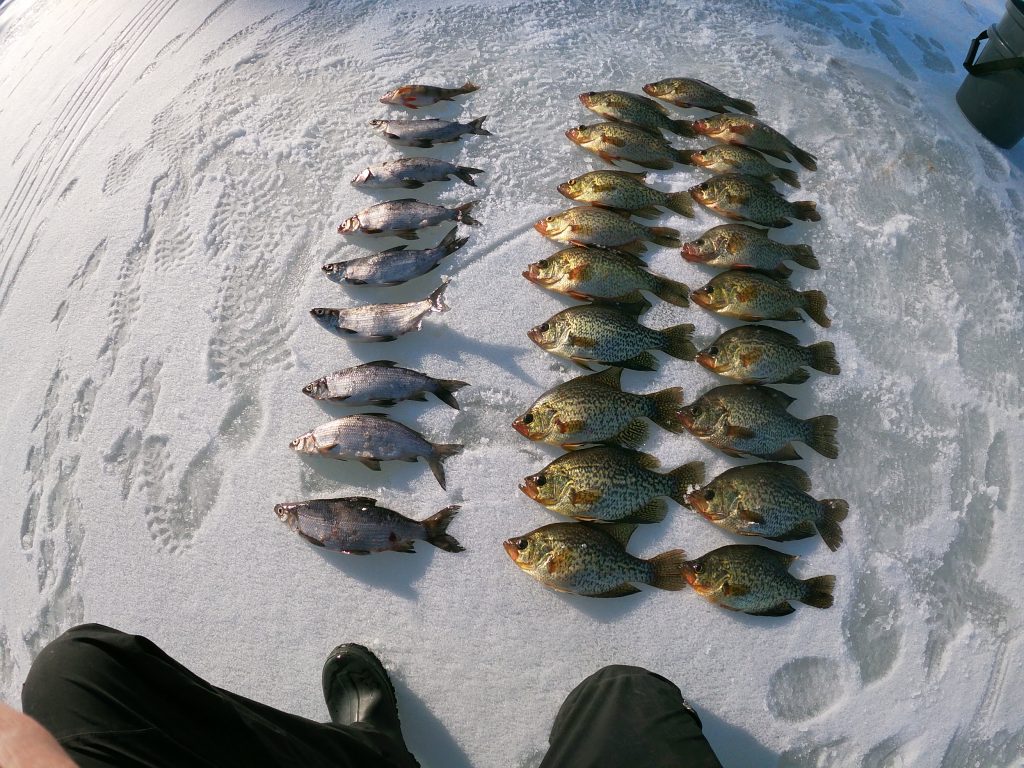
This Lake is a healthy fishery. I can’t wait to return after ice-out and chase walleyes from a canoe. If the health of the crappie population is any indication of the overall health of the Lake, it should be an excellent fishery for years to come. Other than the one small crappie, all the fish we caught were in the same year class, ranging from 11 3/4” to 13”. I can’t wait to catch them next spring when they are even bigger.

In addition to the great fishing, we were also experiencing fantastic weather. We reached a high of 46 degrees and the sun was out almost the entire day we were on the lake. The wind was strong enough to keep the ice cool, so we weren’t standing in any water. There were times in the morning when we wished we would have had a shelter due to the biting wind, but once the adrenaline kicked in from catching giant crappies, we had all the body heat we needed to stay warm.

By 6pm, our energy was waning, temps were dropping, we were losing daylight and we hadn’t had a nibble in over an hour – the bite seemed to be done. We had initially planned to fish until dark, which in my experience was always the best time to chase crappies, but the thought of hiking back in the dark, cold and tired wasn’t appealing. We decided to start hiking out and take advantage of the last minutes of daylight for travel. The lake travel was again very smooth and went quickly. It wasn’t until we hit the winter use trail between the lakes that we started to struggle.
The warm sun had made the previously packed snow on the winter use trail brittle and slushy. It seemed that we were breaking through the soft crust and post-holing every other step. This ½ mile was really tough going, demoralizing and soaked our feet before the long portage which was now uphill on the way out. By the time we scrambled back up the portage and to our snowmobile in the parking lot, we were about ready to collapse. Even though it was grueling day, we all agreed that it was a perfect way to keep our sanity during this awkward shelter in place order. While we did see other people out fishing and did take some time to chat when appropriate, we were able to keep our distance, behave in safe manner without diminishing our experience.

I do plan to return at least once before ice out. Even though we had a fish fry when we returned that evening, I’ve still got close to my limit in the freezer, so my next visit will likely be catch and release.
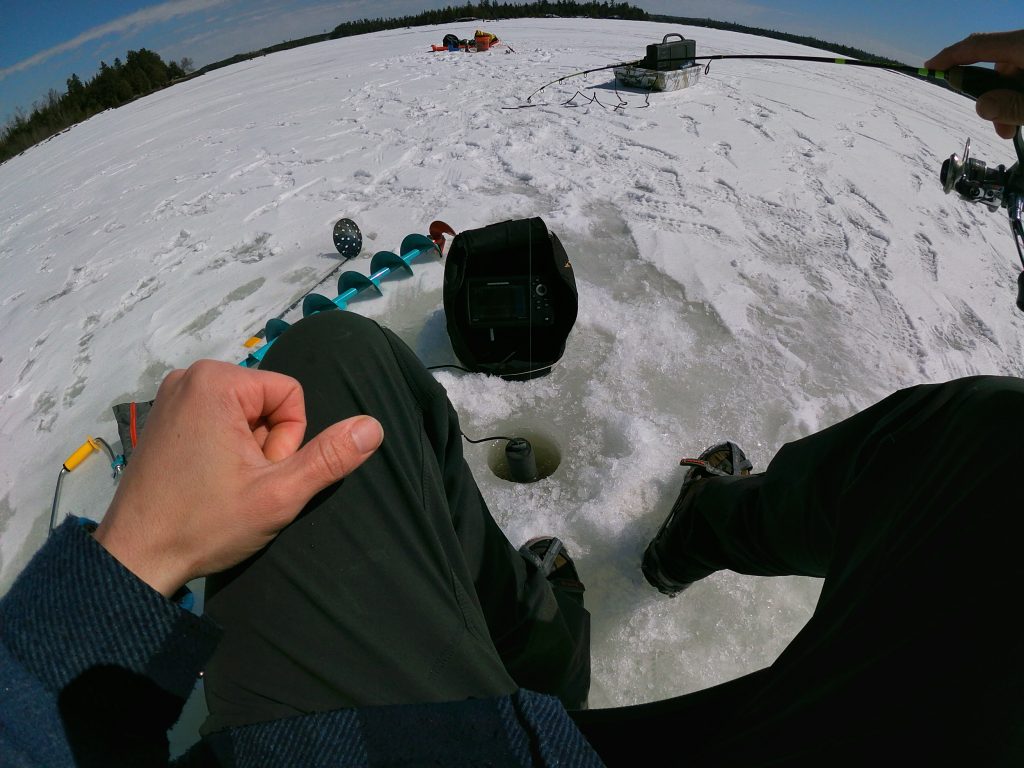
Even with the spectacular fishing that the Boundary Waters have to offer, it is pretty rare to show up at a lake you have never fished and have such a great day of fishing. The quantity and quality of the fish we were catching was impressive, to say the least. For anyone looking for their next spring break/early spring cabin-fever plans, look no further than the Boundary Waters. I have always been amazed at the lack of folks who venture into the BWCA during the offseason (October – April). This is the time of year when the BWCA is almost vacant, permits are free and you do not need to reserve ahead of time. Additionally, since it is the offseason, food and lodging are cheap and especially in March and early April – the travel is easy. When you stop in Ely, don’t forget to support your local bait shop, gas station, restaurant, grocery store, and of course stop to say hello to your Friends in the Great Northwoods.
Eric

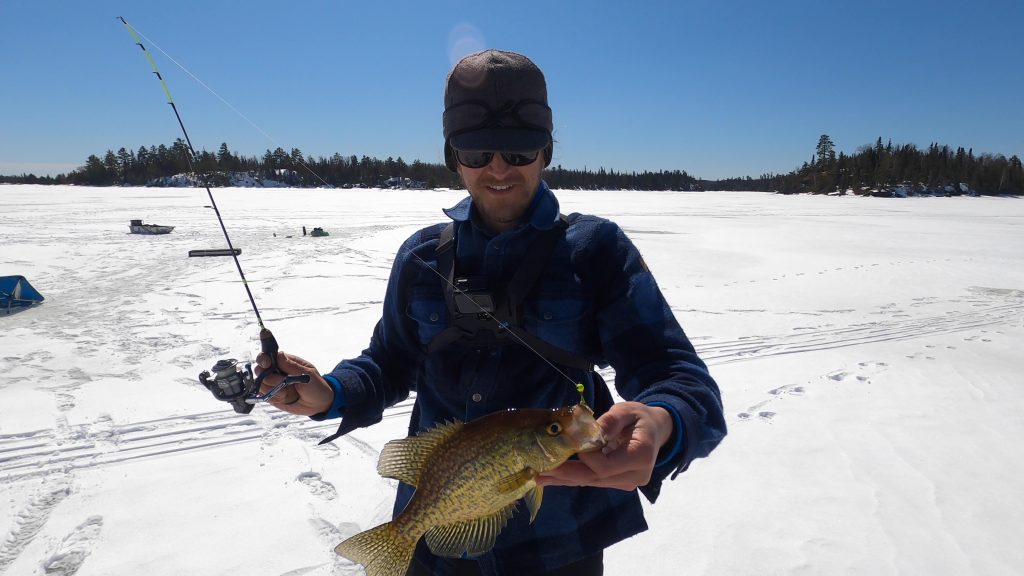
Loved the chronicle of your day! I have canoed and fished extensively In the BWCA as well as in nearby areas of Ontario. In particular, I guess I’ve done most of my fishing on Lac LaCroix. Thanks for sharing! Note: I recently purchased a loon lapis pendant from you as a Xmas gift for my wife. Love MN!! Stay well.
We frequency catch Tullibee ice fishing in the Grand Rapids area. White Fish and Tullibee (also known as Lake Herring) are different species.
I enjoyed reading your blog report.